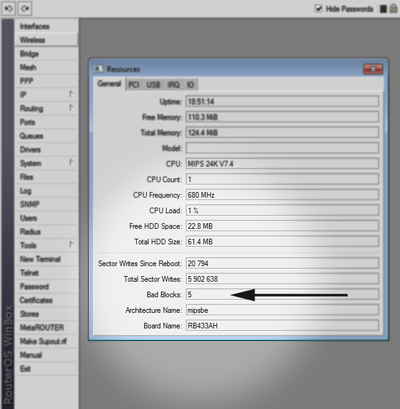Manual:RouterBOARD bad blocks
Every once in a while, one can notice a number of bad blocks appearing in the RouterBOARD resource page. A bad block indicates a problem to write in one part of the NAND storage device, but it doesn't affect the performance of your router, and it doesn't give any indication of quality. According to the manufacturer of NAND chips, up to 5 blocks can be bad when NAND is manufactured, and up to 80 bad blocks could develop during operation, but it will not disturb the operation of your router, because complex workaround mechanisms are in place, that will copy the data to another block and attempt to fix the bad block.
- Note! If more than a 100 bad blocks (more than 5% in new versions) should develop in the NAND chip of a RouterBOARD device, you should try to reinstall RouterOS with Netinstall, and it will reduce the number of bad blocks
Since RouterOS v5.18, NAND is refreshed every few minutes which increases sector writes by ~32 per refresh. This is to ensure evenly distributed NAND wear, to increase protection against data loss as compared to previous versions. As the manufacturer of the NAND chip guarantees 100'000 write cycles to the NAND sectors, 32 sector writes per refresh would mean NAND life is about 100'000 weeks.
If you are planning to use the RouterBOARD as an active caching or logging server, an external drive or a replaceable memory card could be a better alternative than keeping them on the NAND chip. Note that several RouterBOARD models support USB external drives and different types of memory cards.
Important! As you can see in the screenshot above, RouterOS shows you writes per NAND TOTAL, not writes per sector. This is different than the given 100'000 write guarantee per sector.
See also
- Hynix NAND datasheet
